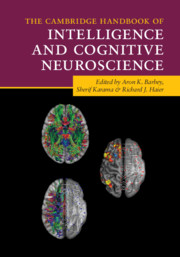Book contents
- The Cambridge Handbook of Intelligence and Cognitive Neuroscience
- Reviews
- The Cambridge Handbook of Intelligence and Cognitive Neuroscience
- Copyright page
- Dedication
- Contents
- Figures
- Tables
- Contributors
- Preface
- Part I Fundamental Issues
- Part II Theories, Models, and Hypotheses
- Part III Neuroimaging Methods and Findings
- Part IV Predictive Modeling Approaches
- 16 Predicting Individual Differences in Cognitive Ability from Brain Imaging and Genetics
- 17 Predicting Cognitive-Ability Differences from Genetic and Brain-Imaging Data
- Part V Translating Research on the Neuroscience of Intelligence into Action
- Index
- References
17 - Predicting Cognitive-Ability Differences from Genetic and Brain-Imaging Data
from Part IV - Predictive Modeling Approaches
Published online by Cambridge University Press: 11 June 2021
- The Cambridge Handbook of Intelligence and Cognitive Neuroscience
- Reviews
- The Cambridge Handbook of Intelligence and Cognitive Neuroscience
- Copyright page
- Dedication
- Contents
- Figures
- Tables
- Contributors
- Preface
- Part I Fundamental Issues
- Part II Theories, Models, and Hypotheses
- Part III Neuroimaging Methods and Findings
- Part IV Predictive Modeling Approaches
- 16 Predicting Individual Differences in Cognitive Ability from Brain Imaging and Genetics
- 17 Predicting Cognitive-Ability Differences from Genetic and Brain-Imaging Data
- Part V Translating Research on the Neuroscience of Intelligence into Action
- Index
- References
Summary
Statistical genetics and brain imaging are together at the technological forefront of research into human intelligence. While these approaches have historically had little practical overlap, they are united both conceptually and in several broad methodological challenges. In concept, both areas attempt to explain complex human behavior by understanding its biological origins, and in doing so have faced the problems that arise from this complexity. The prospect of finding large-effect predictors, for example, has shaped both histories: statistical genetics, with its study of candidate genes that were once thought to have outsized influence on the development of many traits, and neuroscience, with its search for localized brain properties underlying complex behaviors. Both of these areas have then had to adjust their scope and methodology to address the issue of making valid and meaningful predictions from a large number of predictors with small effects. A key understanding is that larger samples of participants than originally employed may be necessary for these predictions to be accurate and useful.
- Type
- Chapter
- Information
- Publisher: Cambridge University PressPrint publication year: 2021



